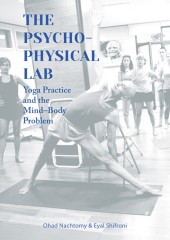The Psychophysical Lab: Yoga Practice and the Mind-Body Problem
Ohad Nachtomy, Eyal Shifroni, The Psychophysical Lab: Yoga Practice and the Mind-Body Problem, Tel-Aviv, Mudita Books, 2019, 375 p.
À propos de l'ouvrage
From the outside, yoga practice may seem like a body culture, much like gym practice or some other kind of workout. But every yoga practitioner knows that yoga practice is much deeper than that, since it develops both physical (bodily) and mental capabilities. Take for example the capability to balance: Can balancing in a pose, like Vrksasana (Tree Pose) be achieved without developing mental capabilities such as focus, concentration and observation? What do we learn when we practice balancing? Is balance merely the ability to find physical equilibrium in a pose, or does it apply more generally to our life beyond the practice mat?
In this book we discuss such issues and argue that yoga practice fosters many capabilities (such as balance), some are mainly physical, others more mental in nature. We illustrate this (in Chapter 1) by presenting ‘Explorations’ – asanas variation done with and without props, in which the reader/practitioner is asked to reflect upon his/her mind-body connections and their mutual affects. We term this ‘Psychophysical Lab‘, since, as in an ordinary lab, reflective practice calls for experimentation and study. In chapter 2 we discuss psychophysical capabilities such as: stability, flexibility, managing effort, persistence, discipline, sensitivity, tolerance, equanimity and relaxation.
In contrary to these experiences, Western philosophy sees a dichotomy between minds (or, as Descartes calls them, thinking things) and bodies (extended things), and views them as separate entities. This difficulty is termed ‘The Mind-Body Problem’. Chapter 3 builds on the observations made in Chapters 1 and 2 and offers a philosophical and historical analysis of this problem —its origin, development, and possible solution.
Finally, chapter 4 contains practice-sequences that have strong mental bearings. We offer five such sequences (some have two variants, according to the level of the practitioner):
- Confidence building (and reducing worry and anxiety)
- Emotional balance (and coping with irritation) – encouraging Sattvic tendencies
- Optimism and joy (and clearing light depression) – tackle Tamasic tendencies
- Calming and pacifying (and countering hyper-activity)- tackle Rajasic tendencies
- Restoration (and recovering from fatigue)
Plus d'informations (site de l'éditeur)
Vidéo : Ohad Nachtomy présente son ouvrage "The Psychophysical Lab - Yoga Practice and the Mind-Body Problem" à l'IEA de Princeton.
|
|
|
Leibniz et le réenchantement de la nature 01 septembre 2018 - 31 janvier 2019 |
|
|

